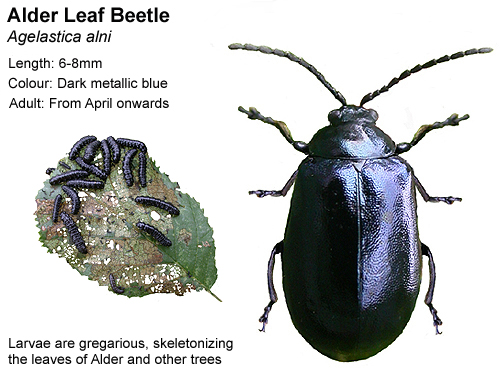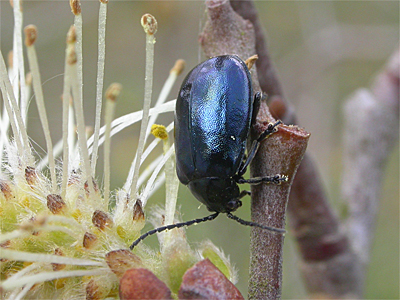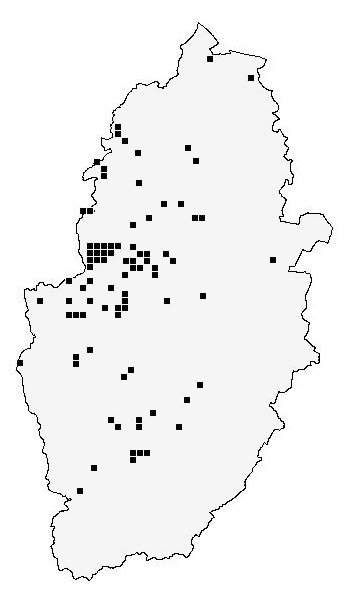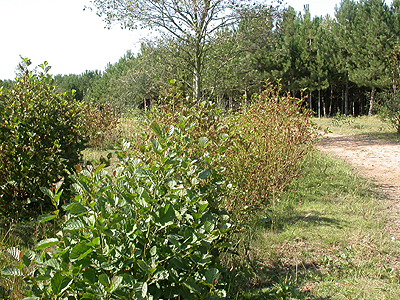

| The Alder Leaf Beetle in Nottinghamshire |
| Once regarded as being extinct in the UK and even considered as being a migratory species, the Alder Leaf Beetle Agelastica alni (Linnaeus, 1758) has recently undergone a sudden expansion of range, with a string of records stretching from Merseyside, across the country to the Humber. | ||
| ..... |
| Scattered records from
many southern counties of the UK, would perhaps tend to
agree with the Alder Leaf Beetle having migratory tendencies. But after being found in Nottinghamshire for the first time in 2014, it looks as though this dark, metallic blue leaf beetle, has colonised the county from populations in the north-west UK. Hundreds were recorded on the banks of the River Don in Sheffield City centre and from Chesterfield (Dutton, C.) either side of Nottinghamshire's first record at Dyscarr Wood, north of Worksop (Bradford, P.) on June 11th 2014. Present UK status A nationally rare beetle, previously believed to be extinct in the UK. With numerous records in the past few years, its current RDB K (insufficiently known) status, is not to remain for much longer and it will be downgraded. |
 |
|
| ..... | ||
| On the basis of the
recent increase in records and UK range, it will almost
certainly be downgraded to a lesser rarity status at a
future date. Nottinghamshire records and current distribution When we originally published this page in September 2015, the Alder Leaf Beetle had been recorded from just five Nottinghamshire sites. Of these five sites, all but Dyscarr Wood were former Colliery spoil heaps and all were in the north-west of the county in the Mansfield and Worksop areas. Nottinghamshire's first record was from Dyscarr Wood, when Agelastica alni was found and photographed by Pauline Bradford on June 11th 2014. A few months later the same year, we recorded it from Warsop Main Pit Top on September 20th. In early 2015, records again came from the known sites of Dyscarr Wood and Warsop Main Pit Top, but we soon started to receive records from other sites. |
| ..... |
 |
In April 2015, it was found on Shirebrook
Pit Wood by Cliff Toplis, then recorded from Langold by
Rob Johnson and Jane Carruthers and later at Shireoaks
Pit Top by Rob Johnson. In the years since 2014, Agelastica alni has continued to spread to new sites south-east of where it was originally found in the county and has no doubt been helped by the large-scale planting of Alder (Alnus sp) on many of Nottinghamshire's former Collieries. Large numbers quickly built up and the beetle is now found in very large numbers at those sites where it has already been present for a few years. Surprisingly, it has still to appear in the southern-half of Nottinghamshire, although it must only be a matter of time (if it isn't there already). By the end of 2017, we had recorded it from new sites reaching halfway across Nottinghamshire. In Spring, we had found it in good numbers at the Nottinghamshire Wildlife Trust's Idle Valley NR in early April, and at several new sites in the Market Warsop and Meden Vale areas the following month. |
|||
| .... | ||||
| It turned up at Crookford
and Bevercotes Pit Wood near Bothamsall in June and then
at Bilsthorpe in September - this latter record being the
furthest south in the county to date. The small numbers
recorded from both Crookford, Bevercotes Pit Wood and
Bilsthorpe during 2017, are a good indication that it has
recently arrived at all three sites. The top photograph of the two produced below right, shows typical Agelastica alni habitat at Warsop Main Pit Top in September 2014. A total of 20 adults were found at the time the photograph was taken, mostly on the small Alder growing right of centre. A survey in the same area in 2017, produced well over 500 beetles. The lower photograph shows a small section of Alder growing at Manton Pit Wood at Worksop in September 2015. The infested leaves soon become skeletonised and brown and young Alders at many of the sites where the beetle is found, quickly become defoliated. |
| .... |
 |
|
||||
| .... | |||||
| The records for the Nottinghamshire distribution map are currently provided by the following contributors - Pauline Bradford. Trevor and Dilys Pendleton. Cliff Toplis. Rob Johnson. Jane Carruthers. Howard Williams. Phil Lee. NBGRC. Julie Lockett. Nottinghamshire Wildlife Trust. Tim Sexton. Dr Peter Revill. | |||||
| .....1 | |||||
| Preferred
habitat and some observational notes There is no doubt that Agelastica alni is continuing to move to new sites along both the River Poulter and River Meden corridors, but it is certainly not confined to Alder growing in riverine habitats and occurs commonly on the dry, stoney substrate of former collieries and post industrial brownfield sites, wherever Alder seeds freely, or is purposely planted. |
||
| ..... | ||
 |
Sites so far still
producing negative results for Agelastica alni
include Ollerton Pit Wood, Brierley Forest Park and
Gedling Country Park. Several years after closure, the spoil heaps of all of Nottinghamshire's former Collieries were topped with a stone aggregate and soil, then planted with a mix of both deciduous and coniferous trees. The range of deciduous trees included Alder (Alnus glutinosa) and other species of Alnus. Small trees and young regenerative growth are generally most favoured by Agelastica alni, but these soon become stripped of foliage in cases of large numbers of both adults and larvae. As seen at Manton Pit Wood in September 2015 and each subsequent year. Replacement leaf growth is attacked later in the Summer/Autumn, with adults moving to other Alders as food supply becomes short. Left: Agelastica alni damage to regenerative Alder growth at Manton Pit Wood in September 2015. The Alder in the foreground was untouched. |
|
| ..... | ||
| Whilst Alder is clearly the preferred foodpant, we recorded numerous adults feeding on isolated examples of Birch (Betula pendula) and Goat Sallow (Salix caprea) at Manton Pit Wood in 2015. Adult Agelastica alni can be found from April to July and then again in September, with adults occasionally remaining active into early October. | ||